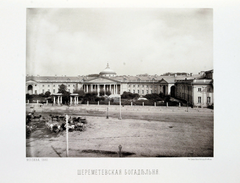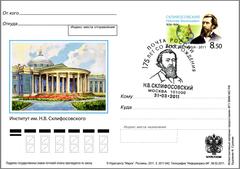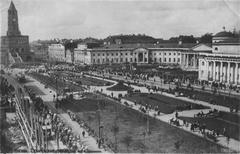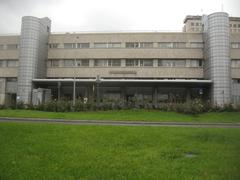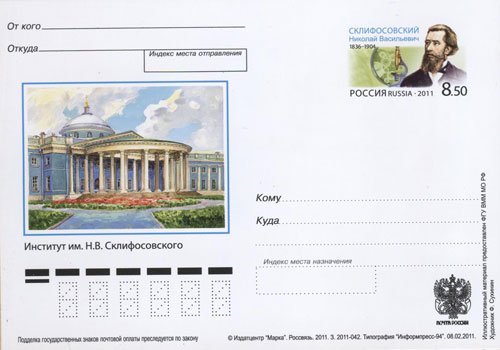
N.V. Sklifosovsky Research Institute For Emergency Medicine
N.V. Sklifosovsky Research Institute for Emergency Medicine Visiting Hours, Tickets, and Visitor Information in Moscow
Date: 14/06/2025
Introduction
Nestled in the heart of Moscow, the N.V. Sklifosovsky Research Institute for Emergency Medicine is a living monument to Russia’s medical heritage and a pioneering center for emergency care. Originally established in 1810 as the Sheremetev Hospital, it was one of the first institutions in Russia to offer free medical care to all, regardless of social status. Named after the renowned surgeon Nikolai Vasilyevich Sklifosovsky, the institute has played a transformative role in the development of trauma and emergency medicine from the Russian Empire through the Soviet era to the present day.
Today, the institute functions as both a leading emergency medical center and a site of cultural interest. Visitors can explore its architectural legacy, attend guided tours on the evolution of emergency medicine, and view exhibitions of historical medical instruments and archival documents. Its central location on Bolshaya Sukharevskaya Square places it amid Moscow’s rich array of historical landmarks.
For the most current visitor information, prospective guests should consult the official N.V. Sklifosovsky Institute website (sklif.mos.ru) and consider using the Audiala app for guided experiences (Audiala).
Table of Contents
- Introduction
- Historical Overview
- Visiting the N.V. Sklifosovsky Research Institute
- Institutional Significance
- Frequently Asked Questions (FAQ)
- Conclusion and Visitor Tips
- Sources and Further Reading
Historical Overview
Origins: Sheremetev Hospital
Founded in 1810 by Count Nikolai Sheremetev as the Strannopriimny Dom (Hospitable House), the institute was revolutionary for offering free medical care to all social classes (sklif.mos.ru). Its neoclassical design and egalitarian mission reflected Enlightenment ideals of humanitarianism and scientific progress.
Naming and Development
In the 19th century, the hospital grew alongside Moscow, adding specialized departments and attracting leading medical figures. The appointment of Nikolai Vasilyevich Sklifosovsky, a pioneer in trauma and emergency surgery, marked a turning point. The institute was later named in his honor, cementing its role in advancing emergency medicine (sklif.mos.ru).
Soviet Era and Modernization
Following the 1917 Revolution, the hospital became the Sklifosovsky Institute for Emergency Medicine (1923), serving as a flagship center for research, clinical practice, and training. Its contributions to surgery, anesthesiology, toxicology, and critical care were internationally recognized throughout the 20th century.
Today, the institute is a multidisciplinary leader in emergency medicine, collaborating with global partners and responding to major emergencies across Russia (sklif.mos.ru).
Visiting the N.V. Sklifosovsky Research Institute
Visiting Hours and Entry
As a functioning medical facility, general access is limited to protect patient privacy and ensure clinical operations. However, guided tours of the institute’s historic areas and museum are available by prior arrangement.
- Museum Visiting Hours: Tuesday to Sunday, 10:00 AM – 6:00 PM (closed Mondays and national holidays).
- General Guided Tours: Monday to Friday, 10:00 AM – 5:00 PM, by prior appointment.
- Admission: Entry is typically free for guided tours and educational visits; some exhibitions or special events may require tickets. Advance booking is required (Official Institute Website).
Family members of patients should coordinate directly with the admissions office for information about patient visiting hours.
Guided Tours and Educational Programs
Guided tours illuminate the institute’s history, architectural features, and landmark contributions to emergency medicine. Tours often include:
- The museum, housing historic medical instruments, documents, and exhibits from key periods such as the “Yudin era.”
- Explanations of the institute’s role in major emergencies, including responses to wartime and recent crises.
- Access to the historic hospital church and architectural highlights.
Tours are available in Russian, with English-speaking guides on request. Educational programs and public lectures are periodically offered. All tours must be pre-arranged via the website or administrative office (Contact Information).
Accessibility and Travel Tips
- Location: Bolshaya Sukharevskaya Square, 3, Meshchansky District, Moscow. (Moscow Metro Map)
- Public Transport: The nearest metro station is Sukharevskaya (Line 6), a short walk from the main entrance. Several bus routes also serve the area.
- Parking: Limited street parking; public transport is recommended.
- Accessibility: The institute is equipped with ramps and elevators. Visitors with disabilities should advise the administration in advance (Accessibility Information).
Security and Etiquette
- All visitors must present valid ID and pass security screening.
- Photography is allowed only in designated museum and public areas; patient privacy must be respected.
- Modest, professional attire is recommended.
- Maintain low noise levels, avoid mobile phone use in clinical zones, and follow all posted guidelines.
Nearby Attractions
Enhance your visit by exploring nearby historical and cultural sites, including:
- Sukharev Tower ruins
- The Garden Ring, with its vibrant city life and historic architecture
- Local cafes, parks, and museums, such as the Museum of Russian Medicine
Accommodation options like Azimut Hotel Olympic Moscow and Hilton Moscow Leningradskaya are within 1–2 km (Booking.com Moscow Hotels).
Institutional Significance
The Sklifosovsky Institute has shaped the field of emergency medicine in Russia and influenced global best practices. Its historic innovations in trauma care, toxicology, and intensive medicine are internationally recognized. Beyond healthcare, it serves as a cultural symbol and is featured in Russian literature and film. The institute is governed by the Moscow Department of Health and led by Dr. Sergey Sergeyevich Petrikov as of June 2025 (sklif.mos.ru).
Frequently Asked Questions (FAQ)
Can the public visit the institute?
Yes, but only through pre-arranged guided tours or educational programs.
What are the standard visiting hours?
Museum: Tuesday–Sunday, 10:00 AM – 6:00 PM. Guided tours: Monday–Friday, 10:00 AM – 5:00 PM. All visits must be booked in advance.
Is there an entrance fee?
Most tours and museum visits are free; special events may require tickets.
Are tours available in English?
Yes, with prior arrangement.
Is the institute accessible for people with disabilities?
Yes, ramps and elevators are provided; advance notice is recommended.
Are photos allowed?
Yes, in public and museum areas, but not in patient zones.
What COVID-19 protocols are in place?
Current measures may include mask mandates and health screenings. Check the official website or Moscow Department of Health for updates.
Conclusion and Visitor Tips
The N.V. Sklifosovsky Research Institute for Emergency Medicine stands as a beacon of medical innovation and historical significance. Its legacy—from the Sheremetev Hospital’s founding principles to its modern role as a multidisciplinary leader—offers visitors an unparalleled perspective on Russian medical history and architectural heritage.
Advance planning is essential due to active clinical operations and security procedures. Utilize the official website for the latest guidelines, and consider the Audiala app for supplementary guided content. Exploring the institute alongside nearby Moscow landmarks will enrich your experience.
Sources and Further Reading
- N.V. Sklifosovsky Research Institute for Emergency Medicine About Page, 2025
- Visiting the N.V. Sklifosovsky Institute: History, Tours, and Visitor Information, 2025
- Visiting the N.V. Sklifosovsky Research Institute in Moscow: Hours, Tours, and Historical Insights, 2025
- Sukharev Tower Wikipedia, 2025
- Moscow Metro Map, 2025
- Moscow Department of Health, 2025
- Audiala App, 2025

